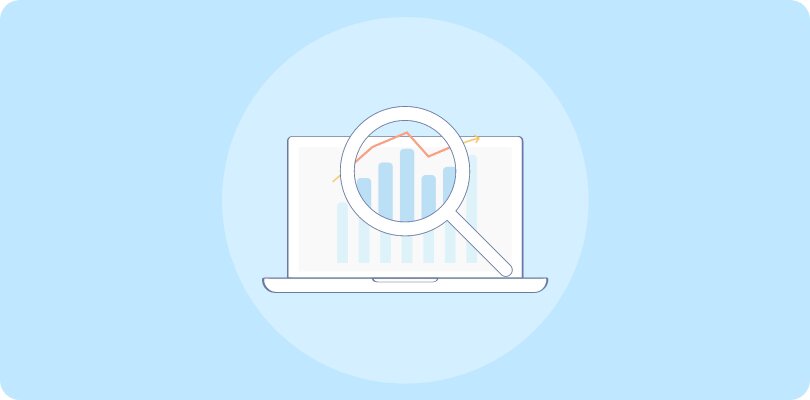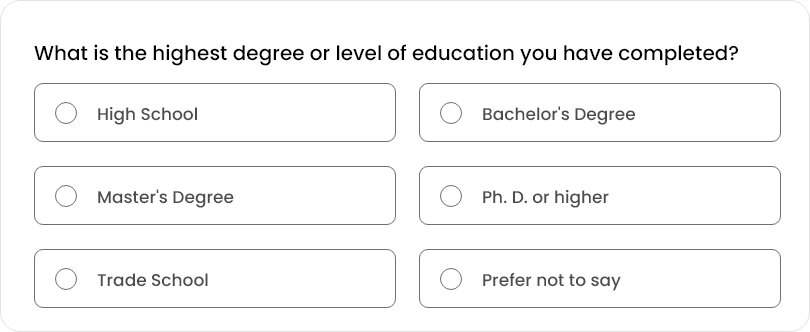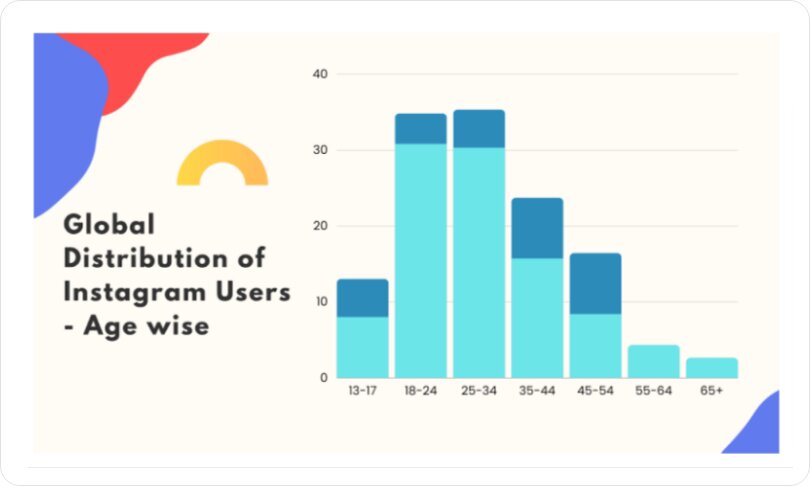
Do you include a demographic survey as a part of your product research strategy?
Without demographic information, your entire marketing strategy can seem directionless. It is nearly impossible to create a marketing plan for your target market without knowing a few basic background information about them.
Let’s face it: The thousands of megabytes of data you’ve gathered from your target audience might not be beneficial if you don’t know “who” you are marketing for.
Whether you wish to excel in market research, product development, or client relations, demographic surveys can help you better understand your customers. Simply including a few demographic questions in the survey will save your business loads of time and money.
In this blog, we will understand demographic surveys, why they are essential for your business, and how to use them effectively for market research.
Let’s dive right in.
What Is a Demographic Survey?
A demographic survey is a market research tool that collects statistical data about your target audience’s traits, such as age, gender, income, education, and more, to provide a curated customer experience.
Collecting demographic data can unlock critical insights into customers or prospects, allowing businesses to develop more effective marketing strategies, personalize products and services, and make informed decisions.
Here is a demographic survey example

Demographic data helps us understand the bigger picture of our target audience, what makes them unique, identify their primary concerns, and how we can provide solutions for them.
Why Are Demographic Surveys Important?
One of the primary purposes of any survey is to gain a comprehensive understanding of your audience, which can be ruined without insights into demographic information.
1. Build Meaningful Customer Relationships
Demographic surveys help businesses better understand the audience and build a strong relationship with them. Apple is a prime example of this; it has become a valuable brand by listening closely to its customers over the years.
Apple’s marketing strategy involves constantly interacting with its tech-savvy customers through various channels and using feedback to improve its products and services. This resulted in increased customer satisfaction, brand loyalty, and success for the business.
2. Increase Conversion Rates
With the correct demographic data, you can focus your time and effort on a suitable customer base and stop wasting your marketing dollars on the people who aren’t interested in your product.
For example, the Stitch Fix label was able to generate a billion dollars in sales and increase conversions by effectively using the data collected from surveys with different algorithms to create a personalized customer experience.
3. Yield Accurate Results
Demographic Surveys are a quicker and more effective method than A/B testing methods. You don’t have to run experiments or spend thousands of dollars testing different product versions to identify the best. With demographic surveys, you can get instant feedback that is accurate and less expensive than A/B testing.
4. Enhance Data Collection
Data is the new oil, and demographic surveys give you adequate information to drive business decisions. With demographic data, you can build different user profiles to understand your customer’s thoughts, emotions, hobbies, and lifestyles.
With this wealth of information, you can customize your ads, and create detailed targeting, to reach your target audience better.
5. Provide Insightful Information
Demographic surveys are an effective way to interact with your customer’s behavior without analyzing their actions such as clicks, purchases, call times, and communication channels. Looking at analytics and other statistical tools can be time-consuming and complex. Instead, you can directly ask your customers for the information you need to improve their experience.
Objectives of a Demographic Information Survey
Understanding demographics can be helpful for businesses to know their target markets, which in turn helps them create better products, services, and marketing strategies.
Here are some of the objectives of a demographic survey:
1. Develop Audience and Buyer Personas
Demographic insights allow you to draw a complete picture of your customers, their needs, and their values. It will help you to build a custom marketing campaign around them—no more throwing assumptions and having a vague customer profile. You will have enough information about your customers to provide customized solutions.
2. Identify Trends
Demographic data allows you to identify existing trends and patterns and predict future market trends. This data can help you find emerging markets, understand the target audience, identify their purchasing habits, measure customer satisfaction, and analyze the competition. For example, a business can send newsletters to potential customers in a particular region if they know email-marketing campaigns yield high conversion rates.
3. Understand Your Target Audience
One of the primary objectives of a demographic survey is to understand the audience better. You can connect with your customers better with as little information as they are a GenZ or Millennial. Knowing your customers’ regions, lifestyles, and primary choices can help create a tailored customer experience to meet the needs and preferences of your target audience.
4. Market to the Right Audience
You can use demographic surveys to evaluate the effectiveness of marketing campaigns. Businesses can better target their advertising efforts and assess the most effective channels, messages, and conversations.
For instance, knowing that your target audience is middle-aged women who prefer email communication instead of young men can significantly improve your marketing efforts.
What Data Is Captured in a Demographic Survey?
Demographic surveys help marketers identify driving factors that determine respondents’ interests, hobbies, and inclinations. The data captured are analyzed and grouped to form a cohesive marketing plan that resonates with the customers.
Let’s look at some of the most common information collected in a demographic survey.
1. Age
Age is a fundamental question to include in your demographic questionnaire. Knowing the approximate age of your target audience can help you understand whether the product will be the right fit for them.
Did you know that over 60% of the global Instagram audiences are aged between 18 – 34?
Businesses can create visually appealing posts and videos that feature their product or services in a way that appeals to this age group’s interests while leveraging the platform.

Sometimes customers may be uncomfortable revealing their exact age, so it is better to include age brackets to gather information. Irrespective of the intended audience, it is good practice to have all age ranges.
Example: “What is your age?”
A. 13 – 17 years old
B. 18 – 24 years old
C. 25 – 34 years old
D. 35 – 44 years old
E. 45 – 54 years old
F. 55+ years old
E. Prefer not to say
2. Gender
Similar to age, knowing the gender identity of your audience is essential for your business. For example, a skincare brand that knows the percentage of male customers is more than female customers can introduce a gender-neutral range of products.
According to WHO, “Gender refers to the characteristics of women, men, girls, and boys that are socially constructed. As a social construct, gender varies from society to society and can change over time.”
Asking about your customers’ gender can be considered a sensitive topic in recent times, and they can easily get offended. So the best way to prepare the question is to include a third option (other or prefer not to say) if they don’t feel comfortable disclosing their gender identity.
Example: “What is your gender identity?”
- Male
- Female
- Prefer not to say
3. Geographic Location
One of the standard ask in any demographic questionnaire is knowing where your customers are from. Without asking, you will never know if your customers are from California or Arizona. Collecting geographic information about customers can provide insights into the difference in consumer behavior, purchasing habits, and preferences that regional or local factors may influence.
On top of that, they can provide an indication of differences in cultural and social factors that influences the market.
There are several ways to collect geographical information. You can ask for the respondent’s country, region, specific city, or zip code if you reach out to audiences locally.
Example: Where are you from?”
A. North America/Central America
B. South America
C. Europe
D. Africa
E. Asia
F. Australia
I. Other: ______
J. Prefer not to say
4. Household Income
Why do you want to know the household income of your potential customer? Knowing the household income gives you an estimate of the economic circumstances and purchasing power.
For example, businesses can use the information to customize their pricing and marketing strategies to appeal to different audiences, such as offering discounts, introducing freemium plans, or special promotions.
As with sensitive information, it would be wise to have a range of answers and include an option to skip the question.
Example: “What is your annual income?”
A. Less than $40,000
B. $40,000 – $60,000
C. $60,000 – $100,000
D. $100,000 – $300,000
E. More than $300,000
F. Prefer not to say
5. Education
Education is an essential variable for businesses mainly because consumer behavior is directly related to their level of education.
Businesses can use this information to develop products or services to cater to their customers with a certain level of education. For instance, a software company specializing in developing cutting-edge accounting software and financial planning tools can strategically target individuals with advanced degrees in finance or accounting.
In a demographic survey, questions relating to education can range from lowest to highest level of education..
Example: “What is your highest level of education?”
A. Less than High School
B. High School
C. Bachelor’s Degree
D. Master’s Degree
E. Ph.D. or higher
F. Trade School
G. Other__________
H. Prefer not to say
6. Marital Status
Customers’ buying decisions can also be influenced by their marital status due to added responsibilities or economic situations.
Example: “Are you married?”
A. Yes
B. No
C. Prefer not to say
Important Note: A long list of questions might make customers lose interest, and they may not submit the survey. Make sure to include only necessary questions for your customer research database.
FREE. All Features. FOREVER!
Try our Forever FREE account with all premium features!
What Are the Four Main Types of Demographics?
When conducting demographic research, four types of data are primarily collected based on each question. This includes psychographic, geographic, behavioral, and socio-economic data. Each provides information about different aspects of customers, which can help them understand their unique needs and preferences.
Psychographic Data
Psychographic data provides information about the population’s values, attitudes, and beliefs. It includes information about their interests, hobbies, and lifestyle. This data help marketers to understand the driving factors behind customers’ purchasing decisions.
For instance, a company that uses renewable energy to develop its products may create marketing strategies emphasizing sustainability and green energy if its target audience values them.
Examples include:
- How much time do you spend traveling to work?
- What is your preferred method of communication with businesses?
Geographical Data
Geographical data collects information about people residing in specific regions and markets. This includes data on their country, state, city, and neighborhood. This data is used to identify regional trends, demand, and patterns, such as employment opportunities, and access to resources.
Examples include:
- What is your Zip/postal code?
- In which state/province do you live?
Behavioral Data
Behavioral data focuses on your customers’ actions and behaviors. It’s not just enough to ask your customers what they think. You need to examine their behavior to reach better conclusions. You can track customers’ preferences, buying habits, and online shopping behavior by analyzing how customers interact with your products, services, and online platforms.
Examples include:
- How frequently do you dine out?
- How often do you travel for leisure?
Socio-Economic Data
Socio-economic data provides a background of social and economic indicators such as your target audience’s financial status and lifestyle. It provides insights into your customers’ income, occupation, education level, and economic variables.
With this information, you can understand your customers’ backgrounds and develop more effective solutions that align with their needs, budgets, and concerns.
Examples include
- What is your occupation?
- Do you rent or own your home?
Know Your Audience Inside Out With a Demographic Survey
Demographic survey questions are essential if you wish to draw a clear picture of your target audience. By gathering and analyzing demographic data such as age, income, gender, level of education, etc., you can design marketing campaigns and strategies to meet your audience’s preferences.
As a best practice, keep the demographic questions clear, concise, and relevant to the business objectives. Avoid making the survey too lengthy, and be mindful of your respondents’ privacy.
Are you looking to create a professional demographic survey and unlock the full potential of your business? ProProfs Survey Maker comes with over 100,000 ready-to-use questions and expert-designed templates to help you capture all the data you need.
 Tips
Tips
We’d love to hear your tips & suggestions on this article!
FREE. All Features. FOREVER!
Try our Forever FREE account with all premium features!


 We'd love your feedback!
We'd love your feedback! Thanks for your feedback!
Thanks for your feedback!







